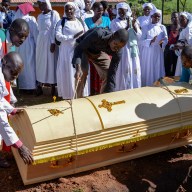The white winter wonderland in which we love to frolic brings weekends filled with children’s giggles — but it can also bring tragedy.
Two weeks ago, an eight-year-old girl was tobogganing with friends in Quebec, when their sled hit a tree. The accident proved fatal for her.
On the same day that story was published, a photo ran of a father and two little girls, of similar age to the one in Quebec, laughing joyfully as they sledded down a hill. Neither the children nor the parent were wearing any type of protective head gear.
According to Dr. Charles Tator, one of Canada’s foremost neurosurgeons, who started the ThinkFirst Foundation of Canada 15 years ago, (working in conjunction with ThinkFirst the National Injury Prevention Foundation in the United States), protecting your head is the best way of protecting yourself. Statistics have shown that 95 per cent of major “catastrophic” injuries, i.e., those that cause death, or lifelong disability like a head/brain injury, or losing a limb or its use, are preventable. And since they’re preventable, they’re not really “accidents.”
The key to reducing injuries is prevention, and the methods of prevention for any type of injury are rarely based on just one factor. For example, snowboarding injuries are on the rise in Edmonton, Alta. But since the number of snowboarders is unknown, the rise in injuries could be directly related to the rise in boarders on the hill.
When it comes to tobogganning, there are some parents who want a mandatory helmet law to be introduced, and others who oppose the restriction. Before a decision is made by the government, parents need to make their own choices. It’s foolish to wait around, depending on the law — especially when it comes to your child’s safety.
Teach your children the basic rules of the hill: never go down head first; never use a hill where there are obstructions, like benches or trees; always walk up the side of the hill; and don’t linger at the bottom — get out of the way of other tobogganners as fast as possible. It’s parents’ responsibility to know where their children will be playing, to walk the hill first, and check the terrain for dangerous conditions and obstacles.
Think about it — if a child ends up with a permanent brain injury, he or she may require special schooling and/or constant supervision, and perhaps never be employed. In total, a broken neck can cost taxpayers about $8 million in health costs, including medical bills, surgical costs, rehabilitation, lost earnings and care.
Last week, a 23-year-old Toronto woman was rushed to hospital after a tobogganing accident — you’re never too old to take precautions.
Dr. Tator suggests, “People who don’t want to wear a helmet, who are vocal about it, should be told it’s OK, if and only if they take full responsibility for their complete medical costs if and when they get injured.”
Be smart, think first. www.thinkfirst.ca


















